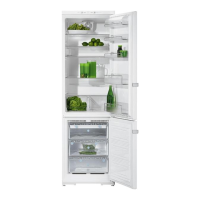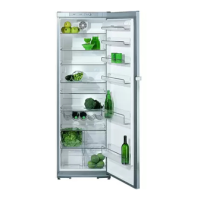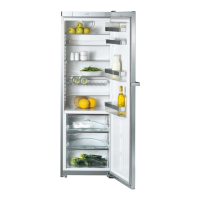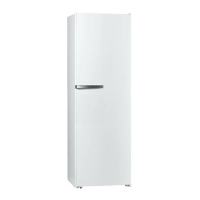Do you have a question about the Miele K 8852 SD and is the answer not in the manual?
Overview of the refrigerator's main parts, including buttons, display, and internal fittings.
Guidelines for environmentally friendly disposal of packaging materials and safety precautions for plastic wrappings.
Instructions for unplugging, disabling, and disposing of old appliances at recycling centers to protect the environment.
Information on coolant safety, flammability, and potential hazards from leaks, plus general safety warnings.
Guidelines for domestic use only, emphasizing safety for children and supervision of elderly/infirm users.
Instructions for initial cleaning, appliance standing time, and connecting to the mains supply.
Procedure for activating the refrigerator using the On/Off dial and checking the temperature display.
Steps for safely switching off the refrigerator by setting the dial to '0' and verifying indicator lights.
Steps for extended periods of non-use, including cleaning and leaving the door ajar to prevent odors.
Guidance on adjusting the refrigerator's temperature dial for optimal food preservation and cooling.
Explanation of how the control panel display indicates the set temperature and its functionality.
Advice on the ideal temperature setting in the refrigerator's middle section for effective food storage.
Explanation of the Super cool feature for rapid chilling and its recommended applications.
Instructions for activating and deactivating the Super cool mode for efficient temperature control.
Details on the Dynamic cooling system for even air circulation and temperature distribution within the appliance.
Procedure for turning on the Dynamic cooling mode using the dedicated button and indicator light.
Understanding different temperature zones in the refrigerator for optimal food placement and preservation.
Guidance on using the coldest area for delicate and perishable foods like meat and dairy.
Advice on using the warmest zone, typically the door, for items like butter and cheese.
List of foods that should not be stored in the refrigerator, including certain fruits and vegetables.
Instructions for repositioning shelves to accommodate varying heights of food items and optimize space.
Guidance on how to modify a split shelf to store taller items, enhancing internal flexibility.
Steps for removing and re-inserting door shelves to customize storage for bottles and condiments.
Instructions on moving the bottle divider to securely hold bottles of various sizes within the door.
Essential steps before cleaning, including power disconnection and removing all food and removable parts.
Detailed guide for cleaning the appliance's outer casing, interior surfaces, shelves, and accessories.
Information on using a microfibre 'E-Cloth' for effective cleaning of surfaces without chemicals.
Advice on cleaning the aluminium door handle to prevent discolouration or damage from improper cleaning agents.
Troubleshooting steps for insufficient cooling, checking temperature dial settings and electrical fuses.
Guidance on reducing cooling intensity and checking the Super cool function if the appliance is excessively cold.
Diagnosing causes for frequent compressor operation, such as ventilation blockages or improper door closure.
Steps to identify and replace a faulty interior light bulb, including safety measures for electrical components.
Explanation of typical sounds like humming, gurgling, and clicking generated by the compressor and coolant.
Troubleshooting tips for vibrations, focusing on appliance levelling, component stability, and external contact points.
Requirements for connecting the appliance in the UK, including plug type, voltage compatibility, and RCD installation.
Instructions for safe fuse replacement in BS 1363 plugs and guidance on obtaining appropriate replacement parts.
Advice on choosing a suitable installation site, considering environmental factors like temperature, dryness, and ventilation.
Information on the appliance's specified climate operating ranges and the importance of staying within these limits.
Requirements for adequate airflow around the appliance, particularly at the rear, for efficient cooling system operation.
Key steps before positioning the appliance, including removing transport clips and clearing obstructions.
Step-by-step instructions for safely detaching the door handle from the appliance door.
Detailed procedure for transferring the door to the opposite side to change from right-hand to left-hand hinging.
Guidelines for integrating 600mm wide refrigerators into kitchen units, including top box and ventilation gap considerations.
Details on how the appliance door fits within kitchen fronts and ensures unobstructed opening and closing.
Requirements for necessary spacing between the appliance and adjacent walls to allow full door swing.
Overview of the refrigerator's main parts, including buttons, display, and internal fittings.
Guidelines for environmentally friendly disposal of packaging materials and safety precautions for plastic wrappings.
Instructions for unplugging, disabling, and disposing of old appliances at recycling centers to protect the environment.
Information on coolant safety, flammability, and potential hazards from leaks, plus general safety warnings.
Guidelines for domestic use only, emphasizing safety for children and supervision of elderly/infirm users.
Instructions for initial cleaning, appliance standing time, and connecting to the mains supply.
Procedure for activating the refrigerator using the On/Off dial and checking the temperature display.
Steps for safely switching off the refrigerator by setting the dial to '0' and verifying indicator lights.
Steps for extended periods of non-use, including cleaning and leaving the door ajar to prevent odors.
Guidance on adjusting the refrigerator's temperature dial for optimal food preservation and cooling.
Explanation of how the control panel display indicates the set temperature and its functionality.
Advice on the ideal temperature setting in the refrigerator's middle section for effective food storage.
Explanation of the Super cool feature for rapid chilling and its recommended applications.
Instructions for activating and deactivating the Super cool mode for efficient temperature control.
Details on the Dynamic cooling system for even air circulation and temperature distribution within the appliance.
Procedure for turning on the Dynamic cooling mode using the dedicated button and indicator light.
Understanding different temperature zones in the refrigerator for optimal food placement and preservation.
Guidance on using the coldest area for delicate and perishable foods like meat and dairy.
Advice on using the warmest zone, typically the door, for items like butter and cheese.
List of foods that should not be stored in the refrigerator, including certain fruits and vegetables.
Instructions for repositioning shelves to accommodate varying heights of food items and optimize space.
Guidance on how to modify a split shelf to store taller items, enhancing internal flexibility.
Steps for removing and re-inserting door shelves to customize storage for bottles and condiments.
Instructions on moving the bottle divider to securely hold bottles of various sizes within the door.
Essential steps before cleaning, including power disconnection and removing all food and removable parts.
Detailed guide for cleaning the appliance's outer casing, interior surfaces, shelves, and accessories.
Information on using a microfibre 'E-Cloth' for effective cleaning of surfaces without chemicals.
Advice on cleaning the aluminium door handle to prevent discolouration or damage from improper cleaning agents.
Troubleshooting steps for insufficient cooling, checking temperature dial settings and electrical fuses.
Guidance on reducing cooling intensity and checking the Super cool function if the appliance is excessively cold.
Diagnosing causes for frequent compressor operation, such as ventilation blockages or improper door closure.
Steps to identify and replace a faulty interior light bulb, including safety measures for electrical components.
Explanation of typical sounds like humming, gurgling, and clicking generated by the compressor and coolant.
Troubleshooting tips for vibrations, focusing on appliance levelling, component stability, and external contact points.
Requirements for connecting the appliance in the UK, including plug type, voltage compatibility, and RCD installation.
Instructions for safe fuse replacement in BS 1363 plugs and guidance on obtaining appropriate replacement parts.
Advice on choosing a suitable installation site, considering environmental factors like temperature, dryness, and ventilation.
Information on the appliance's specified climate operating ranges and the importance of staying within these limits.
Requirements for adequate airflow around the appliance, particularly at the rear, for efficient cooling system operation.
Key steps before positioning the appliance, including removing transport clips and clearing obstructions.
Step-by-step instructions for safely detaching the door handle from the appliance door.
Detailed procedure for transferring the door to the opposite side to change from right-hand to left-hand hinging.
Guidelines for integrating 600mm wide refrigerators into kitchen units, including top box and ventilation gap considerations.
Details on how the appliance door fits within kitchen fronts and ensures unobstructed opening and closing.
Requirements for necessary spacing between the appliance and adjacent walls to allow full door swing.
| Energy Efficiency Class | A++ |
|---|---|
| Built-in Display | Yes |
| Control Type | Electronic |
| Climate Class | SN-T |
| Fridge Interior Light | Yes |
| Lamp Type | LED |
| Door Balconies | 4 |
| Bottle Rack | Yes |
| Egg Balcony | Yes |
| Fresh Zone Compartment | Yes |
| Reversible Door Hinges | Yes |











